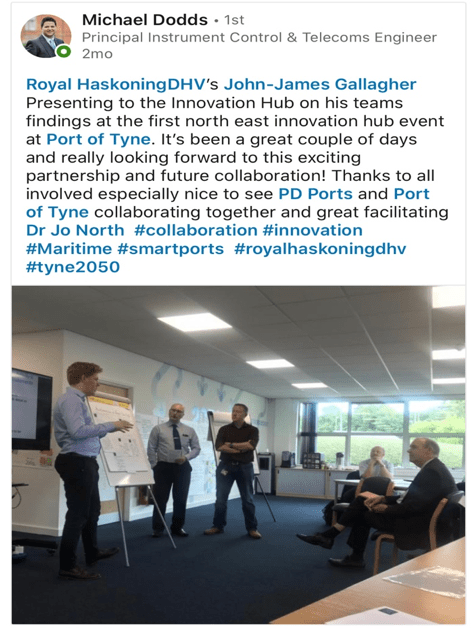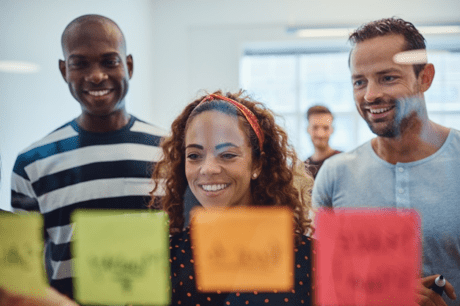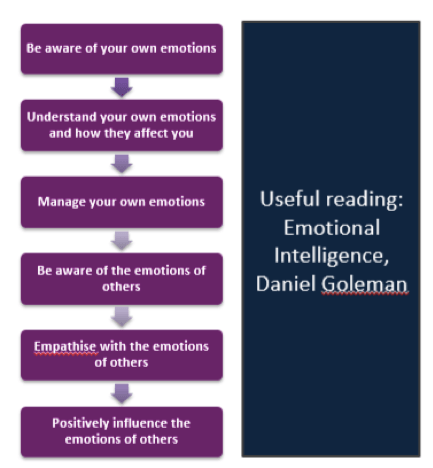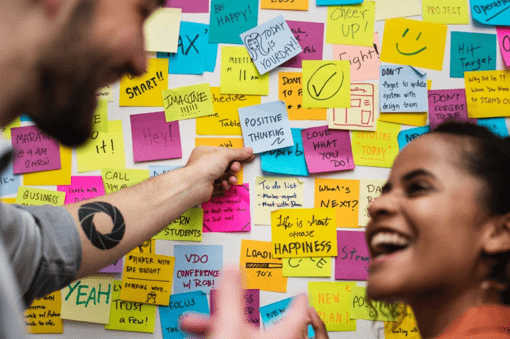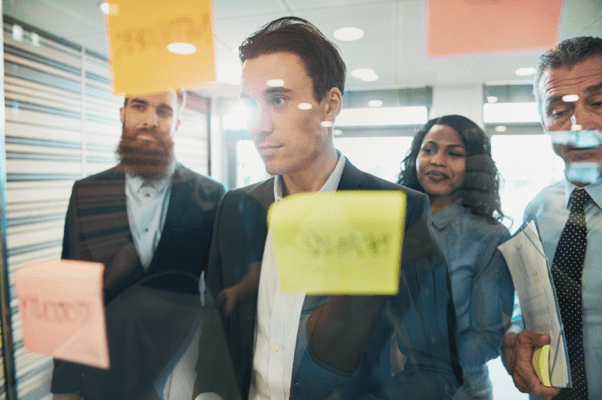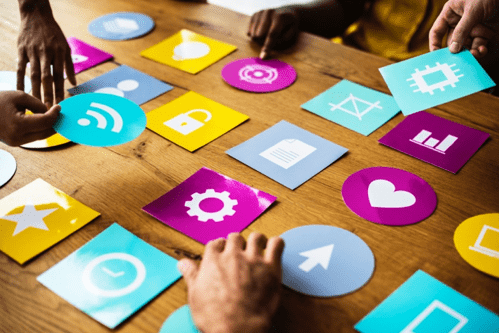Posted in Blog, Create, Grow, Lead by Jo North
Creative Facilitation – An Introduction
Creative Facilitation is my Favourite Thing – Ever!
I have a long history of creative facilitation! I first discovered the potential and creative opportunity that can be achieved from expert facilitation when I did my Masters in Business Administration (MBA) several years ago. I learned then that it is important and very possible to tap into the unique potential of people collaborating in group situations to achieve more together – and, once I started, I became absolutely hooked!
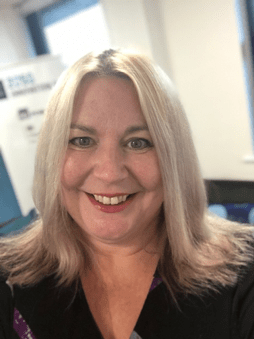
Since then I have designed and delivered workshops, sprints, hackathons, strategy sessions, knowledge exchange events and more for literally thousands of people in all sorts of industries, all over the world, and I have honestly loved every single minute of working with them.
Even the most challenging topics and groups of people are wonderful, because they really stretch and develop the facilitator’s skills. Each and every event is a learning opportunity in its own right for every person involved, delegates and facilitator alike.
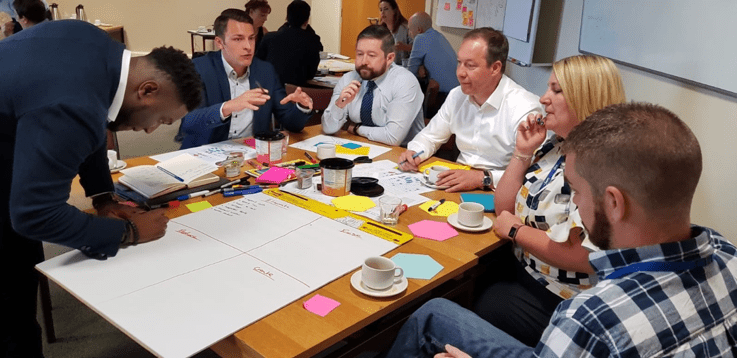
Competence and Confidence
Open Innovation is an approach taken by a business or organisation to access the ideas, technology and knowledge that is available externally, beyond its employees and existing supply chain. Click To TweetWhat’s important as a creative facilitator is to be able to walk into a room full of people, often who you don’t know, to be confident, make an immediate positive impact and get everyone engaged in connecting working with you and delivering fantastic outcomes as a team from the time available.
Excellent creative facilitators make it look really, really easy, but don’t be deceived!
Creative facilitation really is a skill and an art. With study and practice it can be learned, improved upon and developed, though, and everyone can improve their skills. Even the greatest and most experienced facilitators never stop learning!
So, here are just a few of my most important tips, tools, techniques and approaches all in one place to help you to become the most positively impactful facilitator that you can be, in a way that works best with your own authentic and unique personality and style. I will be going deeper into the skill and art of creative facilitation in my future blogs, so if this is something you want to learn more about, do sign up here for my free DIY Awayday Toolkit and to get free facilitation resources and news updates.
Yes please, give me my free Awayday Toolkit
If you have any specific questions about creative facilitation. I will be more than happy to help, and if your query is about something quite complex, I’m also always pleased to hop on a call.
We can also facilitate your event for you, or you might like to join one of our Creative Facilitation Skills training programmes.
If you have any questions or would like to know more, please email me direct at jo@bigbangpartnership.co.uk
Right, let’s get started. We’ll begin with an introduction to the fundamentals of creative facilitation.
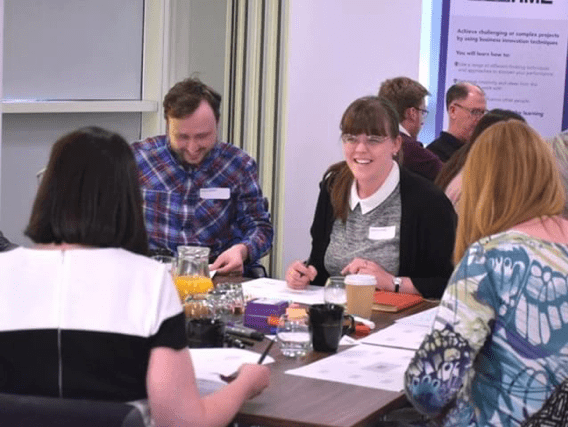
What is Creative Facilitation
What does ‘creative facilitation’ mean in practice?
- Do you just ensure everyone’s introduced, and maybe kick off with a quick ice breaker exercise?
- Is your main role simply to stand by the flip chart and note down all the ideas?
- What preparation do you need to do?
- How do you manage the event, and how exactly do you pull the whole thing together?
In many types of group situations, and particularly in complex discussions or those where people have different views and interests, good facilitation can make the difference between success and failure.
As a facilitator, you may need to call on a wide range of skills and tools, from problem solving and decision making, to team management and communications.
Definition of “Facilitate”
The definition of facilitate is “to make easy” or “ease a process.”
The definition of facilitate is 'to make easy' or 'ease a process'. Click To TweetNerdy fact
Did you know…
…that the word ‘facilitate’ comes from the Latin facilitas, meaning ‘easiness’. So, as facilitators our role is to help ease the process of people thinking and working together in groups.
What a facilitator does is plan, guide and manage a group event to ensure that the group’s objectives are met effectively, with clear thinking, good participation and full buy-in from everyone who is involved.
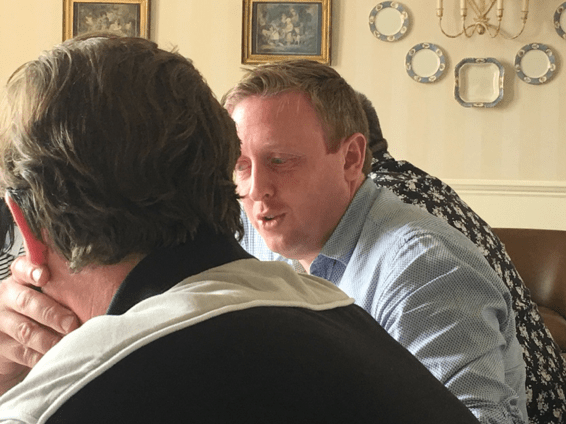
Responsibilities of the Creative Facilitator
Some of the responsibilities involved in being a creative facilitator are:
- Designing and running the session to achieve the agreed objectives.
- Providing space and time for the team to discuss, explore, imagine, challenge themselves and each other, and make key decisions on the way.
- Capturing and recording the outputs visually as the session develops, so that word and ideas don’t just disappear into the ether.
- Keeping people on task when they wander off.
- Supporting and encouraging.

- Maintaining the energy of the people in the room where it needs to be for the task in hand. For example, playful and creative for idea generation, thoughtful and reflective for making important choices.
- Providing the right activity, pace and perspective at the right time.
- Managing time – so that what the team came together to do gets done.
- Getting the group to work at an appropriate level of detail – neither too much nor too little.
- Sometimes, the facilitator’s role may be to energise and almost entertain, to recharge the group. The facilitator is certainly the role model for the everyone else present when it comes to energy, attentiveness, active listening and engagement.
Start with the End in Mind
If you want to be a successful creative facilitator, before every event that you facilitate, ask yourself:
- What words do I want the delegates to use to describe me as a facilitator at the end of the session?
Then think about how your behaviours and approaches will deliver that aspiration and use these words to ‘check in’ with yourself at points throughout your session to keep yourself on track.
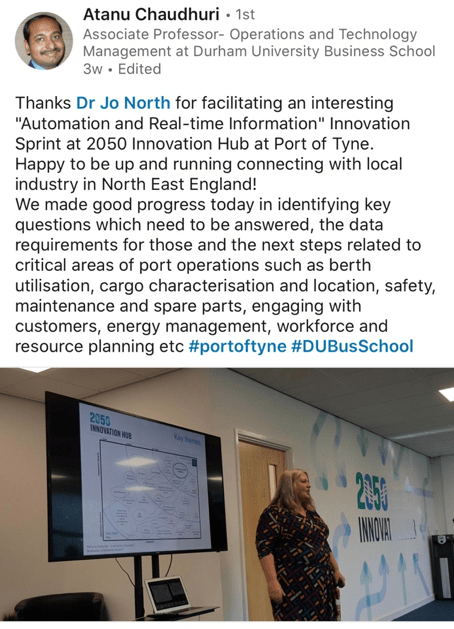
Facilitating Group Sessions
To facilitate effectively, it helps to be as objective as possible. This doesn’t mean you have to come from outside the business or team, though. It simply means that, for the purposes of this group process, you will take a neutral stance. You will step back from contributing to the detailed content and from your own personal views, and focus purely on managing discussions, getting the best from everyone, and bringing the event through to a successful conclusion.
The secret of great facilitation is a group process that flows – and with it will flow the group’s ideas, solutions, and decisions too.
Your key responsibility as a facilitator is to create this group process and an environment in which it can flourish and achieve the its objectives from the session.
Facilitating groups presents unique benefits and opportunities. Some of these are shown here, and I am sure that you can think of others, too.
| Some potential benefits |
| Diversity of thinking styles and approaches |
| Combined input from several different parties |
| Support networking and working beyond a single team |
| Sometimes greater political influence as a mixed than as single function team |
| Wider reach of initiatives |
| Some potential challenges |
| Decision-making processes can be slower |
| People have day-jobs and vested interests |
| Teams send a representative, this can change – levels of commitment / perceived importance may vary |
| Hierarchy outside the group may not apply within it – but expectations may differ |
| No direct authority – influencing and leadership require other strategies |
Delegate Commitment and Motivation
Each delegate will bring different levels of motivation and commitment to participating in the workshop, which in turn can impact their behaviours and approaches, as you can see in the image below.
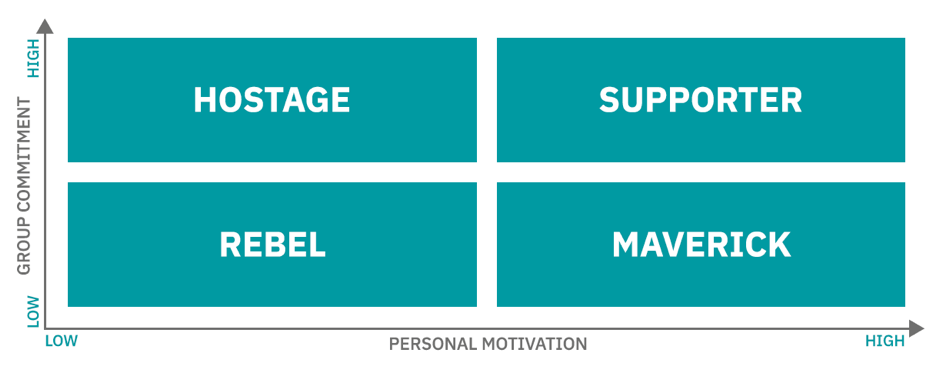
Supporters bring high levels of personal motivation and group commitment to the event. They want to contribute to the overall success of both the group and the task in hand and take pride and enjoyment in knowing that they have made a significant, positive difference as an individual.
Mavericks have low to medium group commitment, and high levels of personal motivation. They can appear unorthodox or independently-minded, sometimes original and nonconformist. Mavericks can play an important role in disrupting ‘group think’, and in challenging accepted norms.
Rebels have low to medium group commitment, and low to medium personal motivation. They are at worse unhappy about attending the event, and at best indifferent. Their aim is to get through the event, contributing as little as possible and avoiding having to take any actions as a result of the workshop.
Hostages have high group commitment and low to medium personal motivation. They want to be and be seen to be team players but are not really interested in the subject at hand. Hostages feel that they should attend to support their colleagues but would much rather be working on something else that is more of a personal priority for themselves.
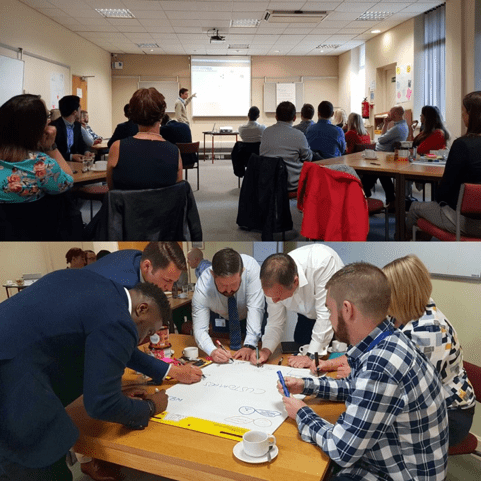
Not everyone falls neatly into one of these boxes, of course, and the same delegate may move through different levels of group commitment and personal motivation at various points throughout the event, depending on factors such as how strongly they agree or disagree with their colleagues in the room, how interested they are in the topic under discussion at that moment, what else is going on outside the workshop, how tired, stressed, or otherwise they are feeling.
The reality that delegates have different levels of motivation and commitment is one that as creative facilitators we need to become accustomed to dealing with and finding our way through.
It is our job to work out how to get the best contribution we can from every individual, whilst giving them the best experience we can. We cannot influence what delegates have ‘brought into the room’ with them or change embedded views in just one workshop. What we can do is to do our best to listen, engage, enthuse and energise.
We cannot influence what delegates have ‘brought into the room’ with them or change embedded views in just one workshop. What we can do is to do our best to listen, engage, enthuse and energise. Click To TweetWork with Adult Learning Theory to Engage Delegates
Applying Knowles’ 4 key principles of adult learning theory across to your facilitation strategy can help to achieve this:
- Involve your delegates in the planning and evaluation of their experience wherever you can.
- Encourage people to actively share their own experiences to help the wider group.
- People are most interested in working on subjects that have immediate relevance and impact to their job or personal life. Work with your delegates to find meaningful links between the workshop focus and their own roles and interests.
- Engage people in problem-solving and solution-finding, as some people really enjoy the challenge and satisfaction that this brings.
Emotional Intelligence and Creative Facilitation
Being able to get the best outcomes possible from all your delegates means having and deploying high levels of emotional intelligence.
Psychology Today defines emotional intelligence as follows:
“The ability to identify and manage your own emotions and the emotions of others. It is generally said to include three skills: emotional awareness; the ability to harness emotions and apply them to tasks like thinking and problem solving; and the ability to manage emotions, which includes regulating your own emotions and cheering up or calming down other people.”
I have created an emotional intelligence self-management process for facilitation (it can be used for many, many other roles or situations too), that I have shown in the image here.
I will walk through it step-by-step, and if you’d like to go deeper into the theme of emotional intelligence, which is also known as ‘EI’ or ‘EQ’, I recommend that you read the book by Daniel Goleman, because it is such an important element in being successful more generally.
Firstly, be aware that we are all experiencing emotions all the time. Even “emotionless” is an emotion! Sometimes our emotions help us to facilitate well, at other times they get in the way. The emotionally intelligent facilitator is able to tune into how they are feeling and put anything negative to one side for the purposes of the event so that they can then communicate more effectively, tune into and positively influence the group dynamic.
Can you think of any recent examples where you have used emotional intelligence effectively?
Now think of a couple of examples that would have benefited from greater emotional intelligence on your part. What happened, how did you feel and behave? What will you do better and differently in the future as a result?
Download your free Awayday Toolkit now
The Seven Key Skills of the Emotionally Intelligent Facilitator
As you may have observed in your reflections, the emotionally intelligent creative facilitator is able to do seven key things:
1. Build and maintain rapport with all the delegates, tuning in to how they are feeling, and what is resonating with them, and tasks or questions they are finding challenging. This means that you will be able to intervene appropriately to build on the positive energy, re-energise the group, or change pace and / or direction.
Some tips on building rapport are to match, without “copycatting”:
-Body language
-Voice
-Spoken language
In a group situation it is likely that people will have a variety of preferences, so you will be able to build rapport more readily with more people if you include variety in your own voice and spoken language.
You can also use body language to match the pace and energy of your group – either to keep the good energy going or take your body language in a different direction to get the group to change tack and signal change.
As a facilitator, you are communicating all the time, whether your think you are or not! The people in the room are continuously ‘reading’ what you say, how you say it and how you are generally being. Your own energy needs to be top notch and switched on throughout your event. You are role-modelling the energy and commitment that you want from the group to get the results that you all want to achieve.
2. Listen and observe with skill and attentiveness. You will see and hear small signals, verbal and non-verbal information from delegates that will enable you to make great facilitation decisions that will help the group. As you are probably aware, most communication is non-verbal, through body language and facial expressions, so observing in order to ‘read’ what people are saying as well as listening to their words is crucial.
It’s also essential that you demonstrate to the group that you are actively listening and observing. There’s an old piece of management advice that is to imagine that everyone has the words “I want to be heard and valued” on their foreheads. Demonstrating that you are engaging with what people are saying will really serve you well as a facilitator, because they will connect more with you and feel more encouraged to contribute.
Here are some top tips for demonstrating active listening and observation when you are facilitating:
- Maintain great eye contact with the person who is speaking (without staring them out, of course!).
- Reflect back and briefly summarise what you have heard from the person who has been speaking.
- Listen to the message and intent behind what is being said, especially when the person speaking is not the most articulate or diplomatic in making their point. It’s important when facilitating to make sure that truly hear what people are wanting to express.
3. Ask great questions. Your rapport-building, listening and observation skills will also help you with the third key skill, which is to ask insightful, pertinent, helpful, thought-provoking and discussion-stimulating questions as appropriate at the right moments throughout your event.
Great questions open up thinking, discussion. They help get to the bottom of messy or challenging topics by probing. They focus the different minds in the room on joint problem-solving and opportunity-finding.
Great questions are open ones, and often start with one of the 5Ws and H:
- Who…?
- What…?
- When…?
- Why…?
- Where…?
- How…?
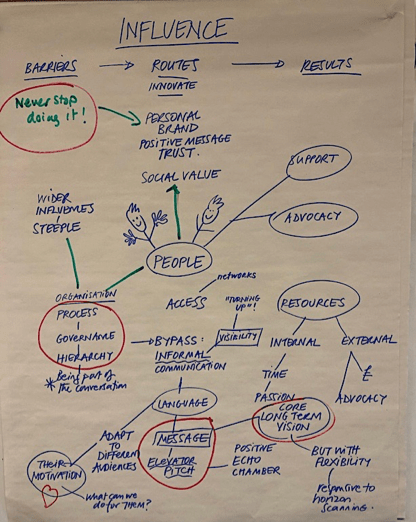
4. Be flexible, agile and adaptable. You can have the best laid plans ever, but sometimes delegates need to spend more time on something that you’d allowed for in your schedule, or unexpected topics and insights come up that need airing. Fantastic facilitators create jazz rather than follow a score. A good design and plan are very necessary but knowing when to flex and having the skills and confidence to do so are absolutely essential. If not, you and your delegates will more than likely experience a dissatisfying and possibly frustrating event.
5. Thinking on your feet is a critical skill for facilitators and is definitely something that gets better and easier with practice and experience.
My biggest tip for being flexible when the workshop is in flow is to slow down to think within the moment by pausing, and also slowing down your speech a little. This will be barely imperceptible to delegates. You will just look like you’re reflecting for a second – which is a good thing.
Pause from Time to Time
If discussions really do take an unexpected turn, and you are wondering how on earth you’re going to get things back on track, or even change them to follow a new one, you could create yourself a bit more thinking time by setting delegates on with a short activity, while you revisit and maybe rejig your plan or timings. You could also give delegates an extra break for 5 minutes.
You don’t have to, but it’s also perfectly acceptable to share what you will be doing with the delegates: “Wow, that was a great session, and we’ve arrived somewhere really interesting. Let’s have a 5 minute coffee break – I’m going to have a quick think about how we can build on those discussions in the next session.”
Or
“That took a bit longer than planned, all time well spent as it was a really insightful discussion. Let’s grab a quick 5 minute break, while I rejig a few timings for later to keep us on track.”
This keeps everyone informed, as well as demonstrating your flexibility.
One thing NOT to do if timings are getting tight is to grind on without breaks. Short breaks, as long as everyone sticks to the agreed start time, make people more productive and engaged.
There is plenty of research that demonstrates that we can really only stay focused for an absolute maximum of 50 minutes. As well as breaks, you can re-energise and refocus the group through switching up activities, getting sub-groups to swap round and work with different people from time-to-time and so on.
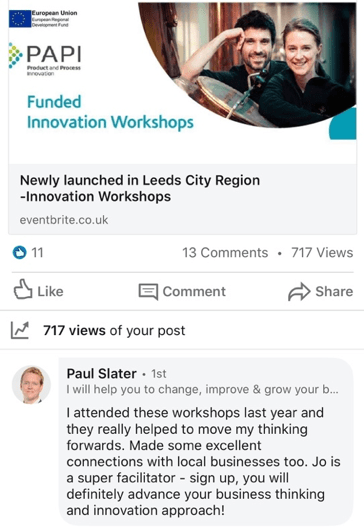
1. Record and visualise outputs. Capturing the work of the group as the event progresses is really important because it turns the nebulous conversation into tangible items that can be referred to throughout the day. The recorded outputs also provide a good record of what happened, what was decided and why for the group once the event is over.
The recording can be on flipcharts, notes – and I often photograph and / or audio record some sessions to make sure that I catch the rich detail, ideas and expressions that are important in some situations to include in the notes that I circulate to the people attending after the event.
2. Guide the group to achieve the event objectives. Of course, creative facilitation events have a purpose. It’s the role of the facilitator to design an appropriate process and then guide the group through that process to successfully attain your intended outcomes.
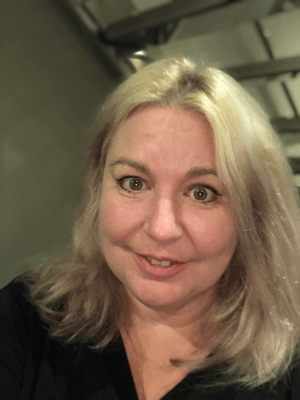
Next Steps
I will be going deeper into the skill and art of creative facilitation in my future blogs, so if this is something you want to learn more about, do sign up here for my free DIY Awayday Toolkit and to get free facilitation resources and news updates.
Download your free Awayday Toolkit now
If you have any specific questions about creative facilitation. I will be more than happy to help, and if your query is about something quite complex, I’m also always pleased to hop on a call.
We can also facilitate your event for you, or you might like to join one of our Creative Facilitation Skills training programmes.
If you have any questions or would like to know more, please email me direct at jo@bigbangpartnership.co.uk.

